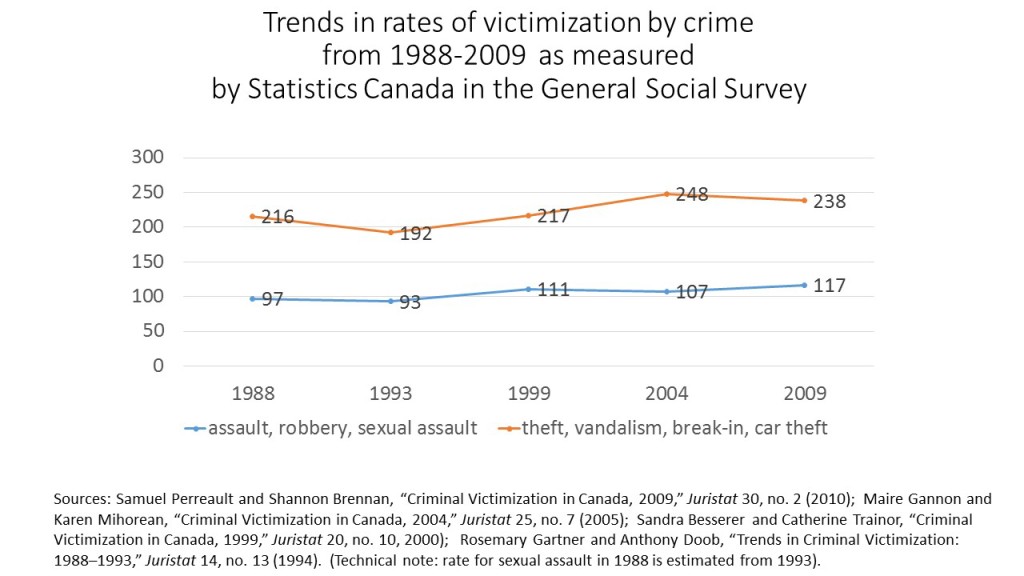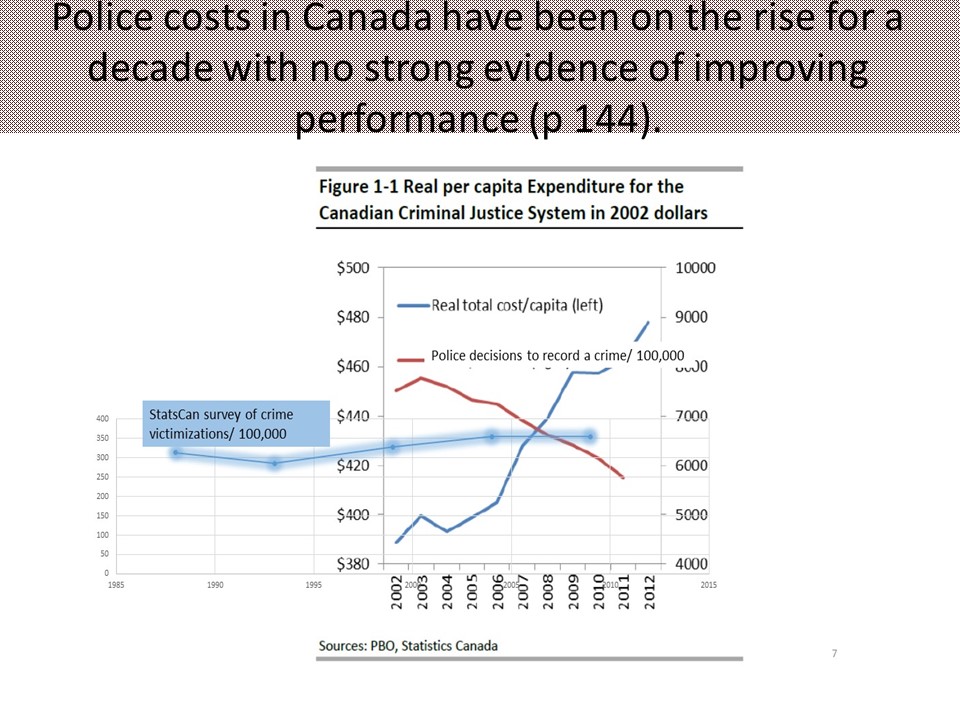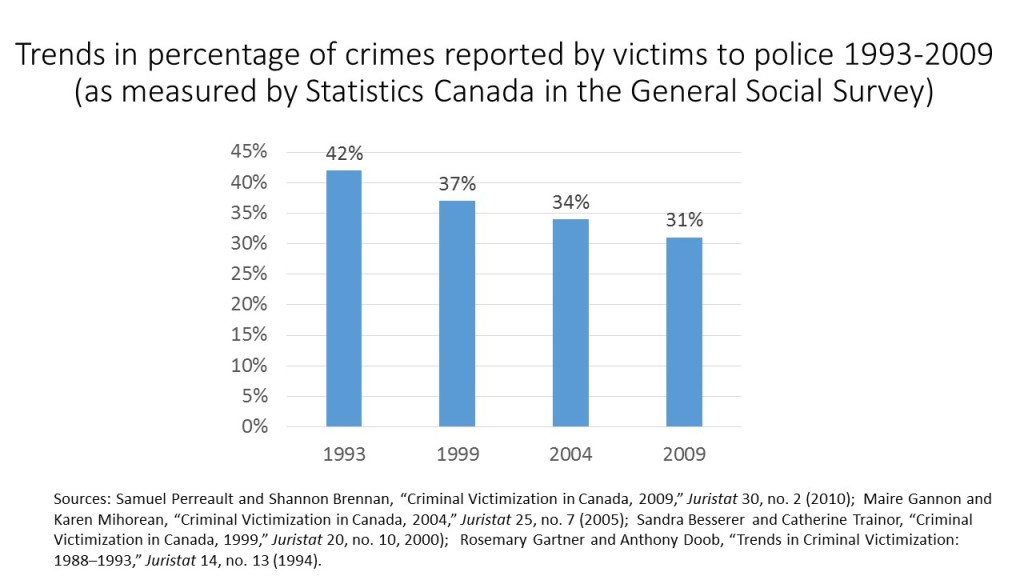Compared to 50 years ago, health policy has led to much longer life expectancy. Technology has led to a much easier life. But criminal justice policy has only recently been associated with rates of street crime close to those in the 1960´s when the USA had 3 Presidential Commissions on violence. We are also now more aware that intimate partner and sexual violence is much more rampant than debated 50 years ago.
Recent innovations in Canada and evidence based initiatives in the USA suggest that a shift in policy could reduce interpersonal violent crime by 50% or more combined with huge savings in tax expenditures. So what do we know about how to make this shift? Will they achieve the potential for a 50% reduction in street crime and intimate partner and sexual violence? Will they reduce taxes on crime and justice by $6 billion in Canada and $75 billion in the USA?
The CCA Panel on the Future of Policing in the 21st century emphasized that policing is just one player in reducing interpersonal violence and providing public safety. My book on Smarter Crime Control reviewed the accumulated evidence on cost effective policing and community safety to show that (i) specific policing strategies that are pro-active and in partnerships to be effective and (ii) that many pre-crime prevention investments are proven to be more cost effective in preventing much of violent crime.
Possible Outcomes of a Shift to Cost Effective Public Safety
1. Reductions of 50% in rates of victimization from street crime and intimate partner and sexual violence with consequent reductions in costs of harm to victims (from $83 billion to $40 billion in Canada from $500 billion to $250 billion for USA)
2. Reductions of expenditures (taxes) on policing and prisons in $billions, particularly at municipal level (from total costs of criminal justice of $21 billion to $17 billion for Canada and from $270 billion to $200 billion in USA))
3. Investment for Social Return of at least $1 for $7, including
a. help parents with kids difficult for them to manage;
b. mentor at risk kids to help them succeed;
c. teach life skills and 4th R in schools to reduce adolescent abuse of alcohol and sexual assault.
4. Shift to proactive policing, such as hot spots and problem oriented policing, and partnerships with social sector
Conclusions from Policing Canada in the 21st Century and Smarter Crime Control
Policing Canada in the 21st Century (Council of Canadian Academies 2014) concluded inter alia (see black bullets and pages) – see white bullets for supplemental statistics
• ¨It is not at all clear that crime rates are declining¨ (p 142)
o Statistics Canada crime victimization surveys show rates of both violent and property crime to be increasing marginally from 1989 to 2009 (Waller, 2015 quoting Statistics Canada Juristats).
o 
• Canadian policing expenditures increased by 50% from 2000 to 2011 after discounting for inflation (p 52)

o Statistics Canada shows increase from $6.8 Billion in 2000 to $13.5 billion in 2012
• ¨Police costs in Canada have been on the rise for a decade with no strong evidence of improving performance¨ (p 144).
o

• ¨The future policing models will be shaped by the reality of police working in the safety and security web¨ (p 141)
o eg for interpersonal crime, police are just one player among the agencies that can prevent violence and so improve safety and security
• A growing body of evidence identifies ¨initiatives with a prevention focus that do not involve police¨ as being cost effective, especially in the area of reducing interpersonal crime (p 147)
• ´A wider reaching governance structures and a stronger system of performance measurement´ are needed through Public Safety and Security Boards (p. 146)
Smarter Crime Control: A Guide to Safer Futures for Citizens, Communities and Politicians (Waller, 2015) concludes inter alia that:
• Much of inter-personal crime is concentrated in a small number of census tracts, characterized by a concentration of people and families with risk factors that are scientifically established as correlating with interpersonal violence (several Statistics Canada studies for police recorded crime and some other studies with victimization survey).
• Prestigious agencies such as the US Department of Justice and the World Health Organization show strong scientific information for what prevents violence by tackling these risk factors.
• US DOJ crimesolutions.gov identifies 78 ¨effective¨ solutions, more than half of which tackle the social roots through pre-crime prevention, such as those to
o help parents with kids difficult for them to manage,
o mentor at risk kids to help them succeed or
o teach life skills in schools to reduce adolescent abuse of alcohol and other drugs.
• Some targeted proactive police programs are effective such as
o hot spots policing and
o problem oriented policing
• Pre-crime prevention programs that tackle risk factors are more effective and cost effective than police programs on their own
• Cities and other programs that combine smart policing and prevention have reduced interpersonal violence by 50% or more.
• There is potential for large reductions in harm to victims of violent crime and savings in taxes by using this scientific knowledge.
• Specific actions are identified for legislators to implement cost effective violence prevention.
Aims of Study
1. To raise awareness of the evidence on (i) what is effective and cost effective in reducing violent victimization and (ii) the importance of ¨partnerships¨ to achieve those reductions;
2. To identify and describe actions, particularly in Canada and USA, that have shifted to using violence prevention knowledge and, where possible, evidence of reduction in crime and taxes;
3. To examine what factors contributed to the successful shift, including the role of moral and financial crises, political awareness and vision, the media, police leadership, task forces, disparity in violence and incarceration, and victim advocacy.
Briefly describe the methods to be used
The study will identify intentional or other situations between 2010 and 2020 that have increased use of proven violence prevention through legislative change, new responsibility centres, political awareness, funding shifts at the State/provincial/city level and so on.
Intentional strategies include in
• Canada: the National Municipal Network for Crime Prevention; Building Partnerships to Reduce Crime; Ontario Crime Prevention Framework for Action; the Economics of Policing Initiatives
• USA: 21st Century Policing Task Force; State of the Nation Address by Obama; Pew Trusts Justice and Public Safety Reinvestment; ACLU Campaign to cut Mass Incarceration by 50% by 2020 (Soros); Everytown for Gun Safety (Bloomberg)
Discussion
In Canada, some municipalities and police leaders are innovating important shifts that focus on evidence, violence prevention and smarter use of police resources and local jails. Some provinces are innovating effective prevention, including relating to gangs and to sexual assault.
In the USA, some police leaders have shifted police arrests towards misdemeanors. Some cities are innovating shifts towards effective prevention. Some political leaders want to reduce mass incarceration and racial disparities in criminal justice. Justice reinvestment is justified in terms of tax savings.
References
Expert Panel on the Future of Canadian Policing Models, Policing Canada in the 21st Century: New Policing for New Challenges, Council of Canadian Academies, Ottawa
Waller, Irvin “Victimology, Victim Services, and Victim Rights in Canada”, Criminology: A Canadian Perspective, 8th edition, Linden, Rick, Toronto, Nelson, 2015.
Statistics Canada, Police Resources in Canada, 2013, Juristat by Hope Hutchins, Ottawa. 2014
Waller, Irvin, Smarter Crime Control, A guide to a safer future for citizens, communities and politicians, New York City, Rowman and Littlefield, 2013
Irvin Waller, Criminology, University of Ottawa
iwaller@uottawa.ca | www.irvinwaller.org | @IrvinWaller
The poster itself is in the new Public Safety police research catalogue at http://www.publicsafety.gc.ca/cnt/cntrng-crm/plcng/cnmcs-plcng/rsrch-prtl/shwttls-eng.aspx?d=PS&i=85203020 H
__________________________________________________________________________________________________________
Full Professor, University of Ottawa; Member CCA Expert Panel on the Future of Canadian Policing Models; Author of Smarter Crime Control, A guide to a safer future for citizens, communities and politicians, New York City, Rowman and Littlefield, 2013



